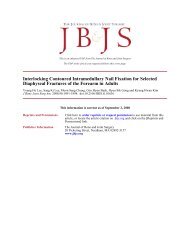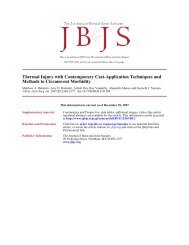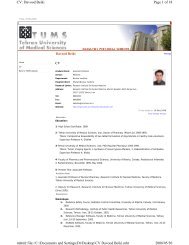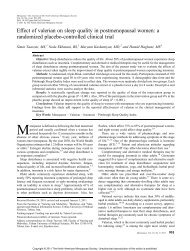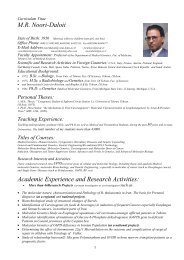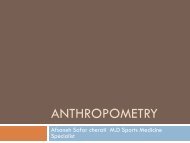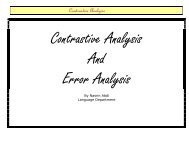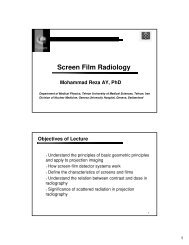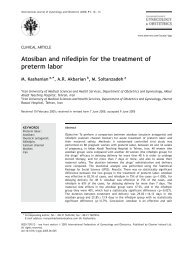A Randomized Clinical Trial Comparing Intralesional Bone Marrow ...
A Randomized Clinical Trial Comparing Intralesional Bone Marrow ...
A Randomized Clinical Trial Comparing Intralesional Bone Marrow ...
Create successful ePaper yourself
Turn your PDF publications into a flip-book with our unique Google optimized e-Paper software.
This is an enhanced PDF from The Journal of <strong>Bone</strong> and Joint Surgery<br />
The PDF of the article you requested follows this cover page.<br />
A <strong>Randomized</strong> <strong>Clinical</strong> <strong>Trial</strong> <strong>Comparing</strong> <strong>Intralesional</strong> <strong>Bone</strong> <strong>Marrow</strong><br />
and Steroid Injections for Simple <strong>Bone</strong> Cysts<br />
James G. Wright, Suzanne Yandow, Sandra Donaldson, Lisa Marley and on Behalf of The Simple <strong>Bone</strong> Cyst<br />
<strong>Trial</strong> Group<br />
J <strong>Bone</strong> Joint Surg Am. 2008;90:722-730. doi:10.2106/JBJS.G.00620<br />
Supplementary material<br />
Reprints and Permissions<br />
Publisher Information<br />
This information is current as of April 9, 2008<br />
Commentary and Perspective, data tables, additional images, video clips and/or<br />
translated abstracts are available for this article. This information can be<br />
accessed at http://www.ejbjs.org/cgi/content/full/90/4/722/DC1<br />
Click here to order reprints or request permission to use material from this<br />
article, or locate the article citation on jbjs.org and click on the [Reprints and<br />
Permissions] link.<br />
The Journal of <strong>Bone</strong> and Joint Surgery<br />
20 Pickering Street, Needham, MA 02492-3157<br />
www.jbjs.org
A <strong>Randomized</strong> <strong>Clinical</strong> <strong>Trial</strong> <strong>Comparing</strong><br />
<strong>Intralesional</strong> <strong>Bone</strong> <strong>Marrow</strong> and Steroid<br />
Injections for Simple <strong>Bone</strong> Cysts<br />
By James G. Wright, MD, MPH, Suzanne Yandow, MD,<br />
Sandra Donaldson, BA, and Lisa Marley, BA, on Behalf of The Simple <strong>Bone</strong> Cyst <strong>Trial</strong> Group*<br />
Background: Simple bone cysts are common benign lesions in growing children that predispose them to fracture and<br />
are sometimes painful. The purpose of this trial was to compare rates of healing of simple bone cysts treated with intralesional<br />
injections of bone marrow with rates of healing of those treated with methylprednisolone acetate.<br />
Methods: Of ninety patients randomly allocated to treatment with either a bone-marrow or a methylprednisolone<br />
acetate injection, seventy-seven were followed for two years. The primary outcome, determined by a radiologist who<br />
was blind to the type of treatment, was radiographic evidence of healing. The cyst was judged to be either not healed<br />
(grade 1 [a clearly visible cyst] or grade 2 [a cyst that was visible but multilocular and opaque]) or healed (grade 3 [sclerosis<br />
around or within a partially visible cyst] or grade 4 [complete healing with obliteration of the cyst]). Patient function was<br />
assessed with use of the Activity Scale for Kids, and pain was assessed with the Oucher Scale.<br />
Results: Sixteen (42%) of the thirty-eight cysts treated with methylprednisolone acetate healed, and nine (23%) of the<br />
thirty-nine cysts treated with bone marrow healed (p = 0.01). There was no significant difference between the treatment<br />
groups (p > 0.09) with respect to function, pain, number of injections, additional fractures, or complications.<br />
Conclusions: Although the rate of healing of simple bone cysts was low following injection of either bone marrow or methylprednisolone,<br />
the latter provided superior healing rates.<br />
Level of Evidence: Therapeutic Level I. See Instructions to Authors for a complete description of levels of evidence.<br />
Although often resolving at skeletal maturity, simple bone<br />
cysts are a common benign lesion in growing children.<br />
They predispose children to fracture, are sometimes<br />
painful, and may restrict function because of concerns about refracture<br />
or a surgeon’s recommendation to avoid physical activity.<br />
Simple bone cysts seldom heal after fracture 1 , so treatment<br />
is often used to speed resolution. Because curettage with<br />
722<br />
COPYRIGHT Ó 2008 BY THE JOURNAL OF BONE AND JOINT SURGERY, INCORPORATED<br />
bone-grafting is followed by a high rate of cyst recurrence 1,2 ,<br />
many minimally invasive methods have been proposed 3-6 . The<br />
reported rates of healing associated with traditional treatment—<br />
intralesional injection of methylprednisolone acetate—have<br />
been widely variable 3,7,8 . A newer treatment—injection of autogenous<br />
bone marrow—was initially reported to result in a<br />
100% healing rate 9 . Subsequent studies have demonstrated<br />
*The Simple <strong>Bone</strong> Cyst <strong>Trial</strong> Group included D. Stephens, J. Crim, K.A. Murray, B. Alman, D. Armstrong, G. Baird, R.M. Bernstein, J. Boakes, J. Bollinger,<br />
K. Carroll, P. Caskey, W. Cole, J. D’Astous, R. Durkin, H. Epps, D. Feldman, R. Ferguson, J. Fisk, K. Guidera, D. Grogan, D. Hedden, A. Howard, M.A.<br />
James, B. Joseph, H. Kim, J. Lubicky, R. Lyon, R. McCall, J. McCarthy, C. Mehlman, M. Murphy-Zane, U. Narayanan, C. Novick, C. Ono, N.Y. Otsuka,<br />
E. Raney, J. Sanders, D. Scher, P. Schoenecker, P. Smith, A. Stans, S. Sundberg, V. Talwalkar, J. Tavares, C. Tylkowski, H. van Bosse, K. Walker, J. Walker,<br />
J.G. Wright, and S. Yandow.<br />
Disclosure: In support of their research for or preparation of this work, one or more of the authors received, in any one year, outside funding or grants in<br />
excess of $10,000 from the Arthur Huene Award, Pediatric Orthopaedic Society of North America (POSNA) research grant, Salter Chair in Surgical<br />
Research, and Shriners Hospitals for Children. Neither they nor a member of their immediate families received payments or other benefits or a commitment<br />
or agreement to provide such benefits from a commercial entity. No commercial entity paid or directed, or agreed to pay or direct, any benefits to<br />
any research fund, foundation, division, center, clinical practice, or other charitable or nonprofit organization with which the authors, or a member of their<br />
immediate families, are affiliated or associated.<br />
A commentary is available with the electronic versions of this article, on our web site (www.jbjs.org) and on our quarterly CD-ROM (call our<br />
subscription department, at 781-449-9780, to order the CD-ROM).<br />
J <strong>Bone</strong> Joint Surg Am. 2008;90:722-30 d doi:10.2106/JBJS.G.00620
d T HE J OURNAL OF B ONE &JOINT S URGERY JBJS. ORG<br />
d d VOLUME 90-A N UMBER 4 A PRIL 2008<br />
lower rates of cyst healing after bone marrow injection(s) 10,11 .<br />
The purpose of this study was to compare the rates of healing<br />
of simple bone cysts following intralesional injection of bone<br />
marrow with those following methylprednisolone injection.<br />
Materials and Methods<br />
Design<br />
This study was a multicenter, randomized clinical trial conducted<br />
at twenty-four centers across North America and<br />
India. It was the inaugural trial of the Pediatric Orthopaedic<br />
Society of North America <strong>Clinical</strong> <strong>Trial</strong>s Network.<br />
Study Participants<br />
All children eighteen years of age or younger with a diagnosis<br />
of simple bone cyst were eligible, including those with previous<br />
fracture(s) or previous (failed) treatment but excluding those<br />
with a malignant tumor, bone marrow disease, chronic steroid<br />
use, chemotherapy, contraindications to steroid use, or pregnancy.<br />
This study received ethical approval from the institutional<br />
review board at each study site.<br />
Baseline Information<br />
We obtained data regarding the patients’ age and sex and details<br />
of prior treatment(s) or fracture(s). Patients completed<br />
the Activities Scale for Kids (ASK) 12-15 , a thirty-item scale focusing<br />
on children’s abilities and the functional activities that<br />
they perform. It has an internal reliability of 0.90 (Cronbach<br />
alpha) and a test-retest reliability of 0.97 (intraclass correlation<br />
coefficient) 14 . Construct validity of the ASK has been demonstrated<br />
by a correlation of 0.81 (p < 0.0001) with the parentreported<br />
Childhood Health Assessment Questionnaire (CHAQ)<br />
and a correlation of 0.92 (p < 0.0001) with clinicians’ observations<br />
15 . Patients also completed the Oucher Scale 16 , which is<br />
used to measure pain in children and has a reported test-retest<br />
reliability ranging from 0.54 to 0.72 (correlation coefficients) 16 .<br />
Construct validity was demonstrated by gamma correlation<br />
coefficients ranging from 0.70 to 0.98 in comparisons with the<br />
Poker Chip Tool 17,18 , and convergent validity was found in<br />
comparison with a visual analogue scale 19 . Discriminant validity<br />
ranged from 0.07 to 0.35 when the Oucher Scale was<br />
tested against standard fear measures, the Hospital Fears Rating<br />
Scale 20 and the Scare Scale 21 .<br />
Radiographic assessment of the lesion included determination<br />
of the cyst-healing grade with Cole’s modification of<br />
Neer’s criteria 3 . Grade 1 indicates that the cyst is clearly visible,<br />
grade 2 indicates that the cyst is visible but multilocular and<br />
opaque, grade 3 indicates sclerosis around or within a partially<br />
visible cyst, and grade 4 indicates complete healing with obliteration<br />
of the cyst 1,3,22 . The radiographs were also assessed to<br />
determine cyst activity (the distance from the physis in centimeters)<br />
2 , the cyst area (length by width by depth in cubic<br />
centimeters) based on two orthogonal plain radiographs 23 ,<br />
cyst loculation (present or absent) 23 , location in the lower or<br />
upper extremity 3 , and location within the bone (metaphyseal,<br />
epiphyseal, or diaphyseal). Magnetic resonance imaging was<br />
not routinely performed.<br />
723<br />
C OMPARISON OF I NTRALESIONAL B ONE M ARROW AND S TEROID<br />
I NJECTIONS FOR S IMPLE B ONE C YSTS<br />
Randomization<br />
Randomization was performed after patients were deemed<br />
eligible and had provided informed consent. Patients were randomly<br />
allocated to receive injection of either bone marrow<br />
or steroid (methylprednisolone acetate) in variable (two, three,<br />
or four-patient) random-size blocks stratified by prior fracture(s)<br />
(yes or no) and prior treatment (yes or no). An independent<br />
biostatistician created the randomization schedule<br />
with a computer. Treatment assignments, placed in sequentially<br />
numbered opaque envelopes, were assigned by one of two<br />
trial managers.<br />
Interventions<br />
Technique Common to Steroid and <strong>Bone</strong> <strong>Marrow</strong> Injections<br />
Each patient received a maximum of three injections, with at<br />
least three months between injections. The indication for a<br />
second or third injection was based on the surgeon’s judgment<br />
regarding whether the cyst was healing or not. Patients<br />
with a prior fracture were treated with the injection at least<br />
three weeks after the fracture, and patients with prior treatment<br />
were treated with the injection at least three months<br />
after the previous treatment. Injections were performed with<br />
the patient under general anesthesia. The diagnosis of a<br />
simple bone cyst was confirmed by needle aspiration of clear<br />
or straw-colored fluid 2,23,24 . Contrast medium (50% Hypaque<br />
[diatrizoate meglumine] and 50% sterile saline solution) was<br />
injected to visualize the extent of the cyst. After irrigation with<br />
the contrast solution, a needle (16 gauge for children older<br />
than five years of age and 18 gauge for children five years of age<br />
or younger) was used to break down loculations and scrape the<br />
cyst lining 4,9,10 . If the cyst was multilocular, each cavity was injected<br />
separately 3,10 . Radiographic assessment of venous outflow<br />
was not routinely performed.<br />
Technique Specific to <strong>Bone</strong> <strong>Marrow</strong> Injections<br />
With use of an 11-gauge needle (for patients weighing >75 lb<br />
[>34 kg]) or a 13-gauge needle (for patients weighing £75 lb),<br />
autologous bone marrow was aspirated from the iliac crest and<br />
into a plastic nonheparinized syringe 25-27 . Through a single<br />
skin-puncture site, the surgeon withdrew 2 to 3-mL aliquots of<br />
bone marrow from enough areas within the ilium to obtain 9<br />
to 18 mL of bone marrow, which was then injected into the<br />
cyst 10,25,28,29 .<br />
Technique Specific to Steroid Injections<br />
The total cyst volume was calculated as the maximum length<br />
by width by depth on the anteroposterior and lateral radiographs.<br />
Methylprednisolone acetate, 3 mg/cm 3 of cyst volume<br />
with a maximum dose of 180 mg, was injected into the cyst.<br />
Study Outcomes<br />
Two-Year Outcomes<br />
The primary study outcome was the cyst-healing grade 1,3,22 .<br />
Secondary outcome measures included function (according to<br />
the ASK 15 ), pain (according to the Oucher scale 16 ), number of<br />
injections, subsequent fractures, and complications. The rela-
d T HE J OURNAL OF B ONE &JOINT S URGERY JBJS. ORG<br />
d d VOLUME 90-A N UMBER 4 A PRIL 2008<br />
Fig. 1<br />
Flow of participants through the trial.<br />
tionship of the radiographic and clinical characteristics with<br />
subsequent fractures (yes or no) and healing (cyst grade 3 or 4)<br />
at two years was also evaluated.<br />
The primary outcome was determined by two musculoskeletal<br />
radiologists who were blind to the type of treatment.<br />
The patients and families also were not informed of the<br />
treatment assignment. However, blinding was difficult because<br />
the bone-marrow-aspiration sites generally revealed puncture<br />
marks or mild bruising. The surgeons who administered the<br />
interventions were not blinded.<br />
Statistical Analyses<br />
Sample Size<br />
On the basis of an anticipated rate of ‘‘satisfactory healing’’<br />
(grade 3 or 4) of 80% in the bone marrow group and 50% in<br />
the steroid group 2,3,7,9-11,23,24,30 , with an alpha of 0.05 and a beta<br />
of 0.2 the required sample size was forty patients in each<br />
724<br />
C OMPARISON OF I NTRALESIONAL B ONE M ARROW AND S TEROID<br />
I NJECTIONS FOR S IMPLE B ONE C YSTS<br />
treatment group. The sample size was increased by 10% to<br />
allow for an anticipated 10% loss to follow-up.<br />
Primary and Secondary Outcomes<br />
The primary analysis comparing cyst healing between the two<br />
groups was performed with use of the chi-square test. To adjust<br />
for differences between the two groups at baseline, analysis was<br />
performed with multiple logistic regressions and odds ratios<br />
were used to estimate the difference between the treatment<br />
groups. Additional analyses were performed with use of twoway<br />
or multiway tables, t tests, or analysis of variance, as<br />
appropriate. Continuous data were described by means, medians,<br />
and standard deviations and categorical data, by proportions.<br />
Where appropriate, 95% confidence intervals were<br />
calculated.<br />
Statistical analyses were performed on an intention-totreat<br />
basis so that patients were analyzed according to the
d T HE J OURNAL OF B ONE &JOINT S URGERY JBJS. ORG<br />
d d VOLUME 90-A N UMBER 4 A PRIL 2008<br />
TABLE I Descriptive Baseline Data<br />
Steroid Group<br />
(N = 45)<br />
<strong>Bone</strong> <strong>Marrow</strong> Group<br />
(N = 45)<br />
Nonrandomized Patients<br />
(N = 35)<br />
Continuous variables*<br />
Age (yr)<br />
At entry into trial 9.2 ± 3.6 9.7 ± 3.2 10.1 ± 3.3<br />
At diagnosis 7.6 ± 3.1 8.5 ± 3.2 8.8 ± 3.3<br />
Height (cm) 118.0 ± 25.1 137.3 ± 22.4 140.2 ± 21.7<br />
Weight (kg) 32.4 ± 15.4 40.9 ± 16.2 45.4 ± 24.7<br />
No. of previous fractures 2.4 ± 1.5 2.2 ± 1.6 2.2 ± 1.6<br />
ASK function score (max., 100 points) (points) 86.9 ± 13.0 88.9 ± 17.3 86.2 ± 20.5<br />
Oucher pain score (max., 100 points) (points) 5.7 ± 14.4 3.0 ± 7.6 11.9 ± 14.7<br />
Cyst area (cm 3 ) 88.9 ± 69.8 63.0 ± 58.3 103.0 ± 59.8<br />
Cyst activity (distance from physis) (cm) 1.2 ± 2.1 2.0 ± 2.6 0.7 ± 1.8<br />
Aspirate amount (mL) 19.7 ± 18.1 20.0 ± 22.1 15.1 ± 18.3<br />
Categorical variables†<br />
Male sex 31 (69%) 30 (67%) 25 (71%)<br />
Upper extremity involved<br />
Involved bone<br />
30 (67%) 36 (80%) 20 (57%)<br />
Humerus 30 (67%) 36 (80%) 20 (57%)<br />
Femur 13 (29%) 5 (11%) 12 (34%)<br />
Other<br />
No. of previous fractures<br />
2 (4%) 4 (9%) 3 (9%)<br />
0 9 (20%) 9 (20%) 6 (17%)<br />
1 16 (36%) 23 (51%) 18 (51%)<br />
2 16 (36%) 8 (18%) 5 (14%)<br />
3 3 (7%) 5 (11%) 4 (11%)<br />
‡41 (2%) 0 (0%) 2 (6%)<br />
Previous treatment<br />
Radiographic grade<br />
9 (20%) 7 (16%) 11 (31%)<br />
Grade 1: clearly visible 32 (71%) 34 (76%) 24 (69%)<br />
Grade 2: multilocular 1 opaque 7 (16%) 9 (20%) 5 (14%)<br />
Grade 3: sclerosis 1 partially visible 0 (0%) 0 (0%) 0 (0%)<br />
Grade 4: complete healing 0 (0%) 0 (0%) 0 (0%)<br />
Missing from chart<br />
Cyst loculation<br />
6 (13%) 2 (4%) 6 (17%)<br />
Unilocular 18 (40%) 20 (44%) 5 (14%)<br />
Multilocular 20 (44%) 23 (51%) 23 (66%)<br />
Missing from chart<br />
Location within bone<br />
7 (16%) 2 (4%) 7 (20%)<br />
Metaphysis 23 (51%) 14 (31%) 17 (49%)<br />
Epiphysis 0 (0%) 0 (0%) 0 (0%)<br />
Diaphysis 13 (29%) 15 (33%) 3 (9%)<br />
Metaphysis 1 diaphysis 2 (4%) 11 (24%) 7 (20%)<br />
Metaphysis 1 epiphysis 0 (0%) 2 (4%) 0 (0%)<br />
Metaphysis 1 epiphysis 1 diaphysis 0 (0%) 0 (0%) 2 (6%)<br />
Missing from chart<br />
Aspirate appearance<br />
7 (16%) 3 (7%) 6 (17%)<br />
Clear 5 (11%) 7 (16%) 6 (17%)<br />
Blood-tinged 26 (58%) 23 (51%) 16 (46%)<br />
Bloody 10 (22%) 12 (28%) 11 (31%)<br />
Missing from chart 4 (9%) 3 (7%) 2 (6%)<br />
725<br />
C OMPARISON OF I NTRALESIONAL B ONE M ARROW AND S TEROID<br />
I NJECTIONS FOR S IMPLE B ONE C YSTS<br />
*The values are given as the mean and standard deviation. †The values are given as the number of patients with the percentage in parentheses.
d T HE J OURNAL OF B ONE &JOINT S URGERY JBJS. ORG<br />
d d VOLUME 90-A N UMBER 4 A PRIL 2008<br />
TABLE II Primary and Secondary Outcomes by Treatment Group<br />
Outcomes<br />
Steroid Group<br />
(N = 38)<br />
treatment group to which they had been randomized. Patients<br />
whose parents refused to allow them to be randomized but<br />
permitted us to follow them to assess the outcome (nonrandomized<br />
patients) were compared with randomized patients<br />
in terms of subsequent fractures and two-year rates of<br />
healing. The few children who had been admitted to the trial<br />
and later found to have an aneurysmal bone cyst on the basis of<br />
biopsy and pathological findings, and hence were ineligible,<br />
were dropped from the analyses.<br />
Results<br />
Recruitment and Participant Flow<br />
Recruitment took place between March 1998 and June<br />
2003, with the two-year follow-up period extending to<br />
June 2005. The flow of participants through the trial is shown<br />
in Figure 1. There were 137 eligible patients; the parents of<br />
thirty-five of them refused treatment randomization but allowed<br />
us to follow their child to assess the outcome, and the<br />
parents of twelve refused to allow us to follow their child to<br />
assess the outcome. Thus, the consent rate was 66% (ninety<br />
of 137). All families who refused treatment randomization<br />
wanted to choose the treatment (either steroid or bone marrow<br />
injection) themselves. Of the forty-five patients assigned<br />
to receive steroid injection(s), one did not have an injection as<br />
the cyst healed prior to treatment and five did not complete the<br />
course of the intervention (three injections) as the surgeon<br />
726<br />
C OMPARISON OF I NTRALESIONAL B ONE M ARROW AND S TEROID<br />
I NJECTIONS FOR S IMPLE B ONE C YSTS<br />
<strong>Bone</strong> <strong>Marrow</strong><br />
Group (N = 39)<br />
P Value<br />
(Unadjusted)<br />
Effect Size* and<br />
95% Confidence<br />
Interval (Adjusted)<br />
P Value<br />
(Adjusted)<br />
Healing† 0.07 4.9 (1.4 to 16.8) 0.01<br />
Not healed: grades 1 1 2 22 (58%) 30 (77%)<br />
Healed: grades 3 1 4 16 (42%) 9 (23%)<br />
ASK function score (max., 100 points)‡ (points) 96.9 ± 8.7 96.0 ± 6.1 0.61 0.1 (25.2 to 5.3) 0.97<br />
Oucher pain score (max., 100 points)‡ (points) 3.1 ± 12.1 1.4 ± 6.7 0.44 2.3 (23.9 to 8.4) 0.47<br />
Cyst activity (distance from physis‡ (cm) 1.8 ± 2.7 2.9 ± 2.6 0.09 20.4 (21.9 to 1.1) 0.58<br />
Cyst area (length · width · depth)‡ (cm3 ) 96.2 ± 115.3 68.1 ± 53.4 0.21 18.3 (212.5 to 49.2) 0.24<br />
Cyst loculation†§ 0.95 1.2 (0.1 to 15.1) 0.90<br />
Unilocular 2 (6%) 2 (6%)<br />
Multilocular 31 (94%) 33 (94%)<br />
No. of injections‡ 1.7 ± 1.0 2.1 ± 1.2 0.12 20.5 (21.1 to 0.2) 0.16<br />
Additional fractures† 0.61 0.6 (0.2 to 2.2) 0.42<br />
No 27 (71%) 30 (77%)<br />
Yes 11 (29%) 9 (23%)<br />
Complications† 0.80 0.3 (0.1 to 1.4) 0.12<br />
Fracture or infection 10 (26%) 11 (28%)<br />
None 28 (74%) 28 (72%)<br />
*The effect size is given as the odds ratio for the categorical data and as the difference in proportions for the continuous data. †The values in the<br />
treatment-group columns are given as the number of patients with the percentage in parentheses. ‡The values in the treatment-group columns are<br />
given as the mean and standard deviation. §The data were missing for some patients.<br />
discontinued the protocol because of cyst progression. All of<br />
the forty-five patients assigned to receive bone marrow injection(s)<br />
received the assigned treatment, but eight of them did<br />
not complete the course of intervention (three injections) as<br />
the surgeon discontinued the protocol because of cyst progression.<br />
Seventy-seven of the ninety patients enrolled in the<br />
trial (thirty-eight [84%] of the forty-five in the steroid injection<br />
group and thirty-nine [87%] of the forty-five in the bone<br />
marrow injection group) were included in the final analysis.<br />
Of the thirteen patients not included in the final analysis,<br />
eight were lost to follow-up and five did not have two-year<br />
radiographs.<br />
Baseline Data<br />
As detailed in Table I, the two treatment groups were comparable<br />
at baseline except with regard to body weight (p =<br />
0.03) and the location of the cyst within the bone (p = 0.02).<br />
The randomized and nonrandomized patients (Table I) differed<br />
in terms of body weight (p = 0.05), cyst area (p = 0.05),<br />
types of previous treatment (p = 0.02), location of the cyst<br />
within the bone (p = 0.02), and loculation (p = 0.03).<br />
Two-Year Outcomes<br />
The difference in the two-year rates of healing between the<br />
treatment groups was 19% (odds ratio, 4.9; 95% confidence<br />
interval, 1.4 to 16.8) (Table II). Forty-two percent (sixteen) of
d T HE J OURNAL OF B ONE &JOINT S URGERY JBJS. ORG<br />
d d VOLUME 90-A N UMBER 4 A PRIL 2008<br />
TABLE III Characteristics Associated with Nonhealing and Healing at Two Years<br />
Characteristic<br />
the thirty-eight cysts treated with the steroid healed (grade 3 or<br />
4), and 23% (nine) of the thirty-nine in the bone marrow<br />
group healed. Adjustment for baseline differences in body<br />
weight and the location of the cyst within the bone with use of<br />
binary logistic regression indicated that steroid injection was<br />
significantly better than bone marrow injection for bringing<br />
Nonhealing:<br />
Grades 1 1 2<br />
Healing:<br />
Grades 3 1 4 P Value<br />
Cyst activity (distance from physis)* (cm) 2.04 ± 2.7 2.9 ± 2.6 0.21<br />
Cyst area (length · width · depth)* (cm3 ) 94.6 ± 101.4 53.8 ± 51.3 0.03‡<br />
Cyst loculation† 0.89<br />
Unilocular 3/49 (6%) 1/19 (5%)<br />
Multilocular 46/49 (94%) 18/19 (95%)<br />
Involved extremity† 0.79<br />
Upper extremity 39/52 (75%) 18/25 (72%)<br />
Lower extremity 13/52 (25%) 7/25 (28%)<br />
Location within bone† 0.66<br />
Metaphysis 17/49 (35%) 7/25 (28%)<br />
Epiphysis 0/49 (0%) 0/25 (0%)<br />
Diaphysis 22/49 (45%) 14/25 (56%)<br />
Metaphysis 1 diaphysis 10/49 (20%) 4/25 (16%)<br />
Fracture within 2-yr study period† 0.04‡<br />
0 34/52 (65%) 23/25 (92%)<br />
1 17/52 (33%) 2/25 (8%)<br />
3 1/52 (2%) 0/25 (0%)<br />
*The values in the healing-group columns are given as the mean and standard deviation. †The values in the healing-group columns are given as<br />
the number of patients with the percentage in parentheses. ‡A significant difference.<br />
TABLE IV Associations with Fracture<br />
727<br />
C OMPARISON OF I NTRALESIONAL B ONE M ARROW AND S TEROID<br />
I NJECTIONS FOR S IMPLE B ONE C YSTS<br />
about healing of bone cysts (p = 0.01). A secondary analysis<br />
performed according to the treatment that was actually received<br />
provided similar results (p = 0.09).<br />
There was no difference between the treatment groups<br />
at two years with regard to function (average difference in<br />
ASK scores, 0.1 point; 95% confidence interval, 25.2 to 5.3;<br />
Characteristic No Fracture Fracture P Value<br />
Cyst activity (distance from physis)* (cm) 2.5 ± 2.8 1.8 ± 2.3 0.28<br />
Cyst area (length · width · depth)* (cm3 ) 69.8 ± 59.3 118.0 ± 144.2 0.18<br />
Cyst loculation† 0.84<br />
Unilocular 3/48 (6%) 1/20 (5%)<br />
Multilocular 45/48 (94%) 19/20 (95%)<br />
Involved extremity† 0.18<br />
Upper extremity 49/57 (86%) 17/20 (85%)<br />
Lower extremity 21/57 (37%) 3/20 (15%)<br />
Location within bone† 0.62<br />
Metaphysis 18/55 (33%) 6/19 (32%)<br />
Epiphysis 0/55 (0%) 0/19 (0%)<br />
Diaphysis 28/55 (51%) 8/19 (42%)<br />
Metaphysis 1 diaphysis 9/55 (16%) 5/19 (26%)<br />
*The values in the fracture-group columns are given as the mean and standard deviation. †The values in the fracture-group columns are given as<br />
the number of patients with the percentage in parentheses.
d T HE J OURNAL OF B ONE &JOINT S URGERY JBJS. ORG<br />
d d VOLUME 90-A N UMBER 4 A PRIL 2008<br />
p = 0.97) or pain (average difference in scores on Oucher scale,<br />
2.3 points; 95% confidence interval, 23.9 to 8.4; p = 0.47).<br />
Other secondary outcomes (cyst activity, area, and loculation;<br />
number of injections; subsequent fractures; and complications)<br />
also did not differ between the treatment groups (p ><br />
0.09) (Table II). A fracture occurred in eleven of the patients in<br />
the steroid group and nine in the bone marrow group, and an<br />
infection developed in no patient in the steroid group and in<br />
two in the bone marrow group. The rate of adverse events<br />
within the two-year study period did not differ between the<br />
treatment groups (p = 0.36). After adjustment for cyst area, the<br />
risk of fracture was lower in the methylprednisolone group,<br />
but the difference was not significant (p = 0.42).<br />
<strong>Randomized</strong> and Nonrandomized Patients<br />
Children whose parents refused to let them enter the trial but<br />
allowed us to follow them to assess the outcome (nonrandomized<br />
patients) were compared with the randomized<br />
patients in terms of the rates of healing and subsequent fracture<br />
at two years. There were no significant differences in these<br />
factors (rate of healing, p = 0.6; rate of subsequent fracture, p =<br />
0.5) between the randomized and nonrandomized patients<br />
(with the analysis unadjusted for differences in baseline variables<br />
between the groups).<br />
Associations with Healing and Subsequent Fracture<br />
Both subsequent fracture (p = 0.04) and cyst area (p = 0.03)<br />
were significantly associated with cyst healing at two years<br />
(Table III). The mean baseline areas of the healed and nonhealed<br />
cysts were 53.8 and 94.6 cm 3 , respectively (p = 0.03).<br />
As shown in Table IV, there were no significant associations<br />
between fractures and cyst activity, cyst area, loculation, location<br />
in the upper or lower extremity, or location within the bone.<br />
Discussion<br />
Simple bone cysts are benign lesions in growing children.<br />
Some children with simple bone cysts sustain multiple<br />
fractures. Many children are fearful of subsequent fractures<br />
or are restricted from activity by their physicians. Families<br />
and surgeons would welcome a minimally invasive, low-risk<br />
treatment.<br />
Treatment strategies for simple bone cysts include curettage<br />
and bone-grafting, intralesional injections, damage to<br />
the cyst wall and lining, decompression of the cyst, structural<br />
stabilization, or some combination of these methods. Substances<br />
that have been injected into cysts include methylprednisolone<br />
acetate 8 , bone marrow 9 , calcium sulphate pellets 5 ,<br />
demineralized bone matrix 6 , and calcium-phosphate bone<br />
cement (Norian, Cupertino, California) 31 . Methods for damaging<br />
the cyst lining include scraping with needles or direct<br />
curettage. Decompression of the cyst can be performed with<br />
Kirschner wires 22 or cannulated screws 32 . Flexible intramedullary<br />
nails provide structural stability but also disrupt the cyst<br />
lining and may decompress the cyst 33 . Few comparative studies,<br />
however, have been done to directly evaluate treatment, and<br />
consequently treatment varies widely.<br />
728<br />
C OMPARISON OF I NTRALESIONAL B ONE M ARROW AND S TEROID<br />
I NJECTIONS FOR S IMPLE B ONE C YSTS<br />
Injection of methylprednisolone acetate was the traditional<br />
form of treatment for simple bone cysts for many<br />
years 7,8 . An early study of bone marrow injection demonstrated<br />
a 100% rate of healing after one injection 9 . Although subsequent<br />
studies showed lower rates 4,10,11,30,34,35 , bone marrow became<br />
the preferred substance for intralesional injection at<br />
many centers. The results of the present blinded, multicenter,<br />
randomized trial showed injection of either bone marrow or<br />
methylprednisolone acetate to have low rates of success, but<br />
methylprednisolone acetate provided superior rates. This<br />
study demonstrates the value of prospective comparisons with<br />
blinded evaluation of treatment outcomes. In contrast, case<br />
series often provide inaccurate or overly optimistic estimates<br />
of treatment effectiveness 36 .<br />
In this study, the rates of full or partial healing following<br />
both forms of treatment were lower than those reported in<br />
previous studies 3,7-11 . This difference can be attributed to several<br />
factors. First, blinded evaluation by radiologists who have<br />
no vested interest in the outcome provides a very objective<br />
measure of cyst healing. All too often, surgeons and parents<br />
want to interpret posttreatment radiographs, made with various<br />
techniques, as indicating cyst healing. Second, patients<br />
were followed for two years in our trial. Many cysts that appear<br />
to be healing at one year after injection look no different than<br />
they did before treatment when they are evaluated two years<br />
after the injection. Third, in the initial reports by Lokiec<br />
et al. 4,9 , treatment included the combination of scraping the<br />
cyst, opening the medullary canal, and bone marrow injections.<br />
Although scraping the cyst was part of the trial protocol<br />
in our study, the completeness of this step by the participating<br />
surgeons is unknown. Fourth, patients in this study received<br />
only three injections. Although Hashemi-Nejad and Cole 3<br />
found that more than three injections of steroid did not improve<br />
healing, it is possible that more injections may have<br />
resulted in higher healing rates in both groups.<br />
An important issue for families of children with a simple<br />
bone cyst is the risk of refracture. None of the factors evaluated<br />
in this study were associated with fracture (Table IV). Thus,<br />
the parameters that we evaluated on plain radiographs did not<br />
provide significant prognostic information for families or surgeons.<br />
Quantitative computed tomography may be a more accurate<br />
modality for predicting fracture and evaluating healing<br />
in future studies 37 . The cyst area and fracture were the only<br />
variables found to be related to healing.<br />
The main limitation of this study was that we evaluated<br />
only two forms of treatment, and we do not know how either<br />
of these treatments would fare against no treatment. This was<br />
the first multicenter trial of the Pediatric Orthopaedic Society<br />
of North America <strong>Clinical</strong> <strong>Trial</strong>s Network. It showed that<br />
multicenter trials can provide useful and practical answers to<br />
some clinical questions. Authors of future studies will need<br />
to evaluate other treatments for simple bone cysts. A second<br />
potential limitation of this study was that Cole’s modification<br />
of the Neer grading system 3 offers a liberal definition of<br />
healing (grade 3 or 4). However, using grade 4 only as the<br />
radiographic outcome of treatment would have resulted in
d T HE J OURNAL OF B ONE &JOINT S URGERY JBJS. ORG<br />
d d VOLUME 90-A N UMBER 4 A PRIL 2008<br />
even lower rates of healing in both groups. A third limitation is<br />
that the study was not sufficiently powered to evaluate the<br />
fracture risk in the two treatment groups. Finally, concentrated<br />
bone marrow may have greater potential for achieving cyst<br />
healing than the unconcentrated bone marrow used in this<br />
study 38 .<br />
In conclusion, intralesional injections of methylprednisolone<br />
acetate are superior to injections of bone marrow to<br />
achieve cyst healing. Future trials are needed to compare other<br />
treatments for simple bone cysts in children and to develop<br />
new measures of cyst healing. n<br />
NOTE: The authors thank the trial radiologists, Dr. Crim and Dr. Murray, for their time and effort<br />
in reviewing and evaluating each radiograph in our study. They also thank the trial statistician,<br />
Mr. Derek Stephens, for his input regarding the design, statistical analysis, and interpretation of<br />
the results.<br />
The centers participating in the clinical trial were Children’s Hospital MLC, Cincinnati,<br />
OH, Children’s Orthopedics of Hawaii, Honolulu, HI, Gillette Children’s Specialty Healthcare, St.<br />
Paul, MN, Hospital for Joint Diseases, New York, NY, Kasturba Medical College, Manipal, India,<br />
Mayo Clinic, Rochester, MN, Medical College of Wisconsin, Milwaukee, WI, New England Medical<br />
Center, Boston, MA, Shriners Hospitals for Children, Chicago, IL, Shriners Hospitals for Children,<br />
Erie, PA, Shriners Hospitals for Children, Honolulu, HI, Shriners Hospitals for Children, Intermountain,<br />
Salt Lake City, UT, Shriners Hospitals for Children, Lexington, KY, Shriners Hospitals<br />
for Children, Los Angeles, CA, Shriners Hospitals for Children, Philadelphia, PA, Shriners Hospitals<br />
for Children, Sacramento, CA, Shriners Hospitals for Children, Shreveport, LA, Shriners<br />
Hospitals for Children, Spokane, WA, Shriners Hospitals for Children, St. Louis, MO, Shriners<br />
Hospitals for Children, Tampa, FL, Southern Illinois University School of Medicine, Springfield, IL,<br />
1. Neer CS 2nd, Francis KC, Marcove RC, Terz J, Carbonara PN. Treatment of<br />
unicameral bone cyst. A follow-up study of one hundred seventy-five cases. J <strong>Bone</strong><br />
Joint Surg Am. 1966;48:731-45.<br />
2. Oppenheim WL, Galleno H. Operative treatment versus steroid injection in the<br />
management of unicameral bone cysts. J Pediatr Orthop. 1984;4:1-7.<br />
3. Hashemi-Nejad A, Cole WG. Incomplete healing of simple bone cysts after<br />
steroid injections. J <strong>Bone</strong> Joint Surg Br. 1997;79:727-30.<br />
4. Lokiec F, Ezra E, Meller I, Kollender I, Wientroub B. Percutaneous autologous<br />
marrow grafting in simple bone cysts—treatment considerations and efficacy.<br />
Read at the annual meeting of the Pediatric Orthopaedic Society of North America;<br />
1998; Cleveland, Ohio.<br />
5. Dormans JP, Sankar WN, Moroz L, Erol B. Percutaneous intramedullary decompression,<br />
curettage, and grafting with medical-grade calcium sulfate pellets<br />
for unicameral bone cysts in children: a new minimally invasive technique.<br />
J Pediatr Orthop. 2005;25:804-11.<br />
6. Killian JT, Wilkinson L, White S, Brassard M. Treatment of unicameral bone cyst<br />
with demineralized bone matrix. J Pediatr Orthop. 1998;18:621-4.<br />
7. Campanacci M, Capanna R, Picci P. Unicameral and aneurysmal bone cysts.<br />
Clin Orthop Relat Res. 1986;204:25-36.<br />
8. Scaglietti O, Marchetti PG, Bartolozzi P. The effects of methylprednisolone acetate<br />
in the treatment of bone cysts. Results of three years follow-up. J <strong>Bone</strong> Joint<br />
Surg Br. 1979;61:200-4.<br />
9. Lokiec F, Ezra E, Khermosh O, Weintroub S. Simple bone cysts treated by<br />
percutaneous autologous marrow grafting. J <strong>Bone</strong> Joint Surg Br. 1996;78:934-7.<br />
10. Yandow SM, Lundeen G, Scott SM, Coffin C. Autogenic bone marrow injections<br />
as a treatment for simple bone cyst. J Pediatr Orthop. 1998;18:616-20.<br />
11. Delloye C, Docquier PL, Cornu O, Poilvache P, Peters M, Woitrin B, Rombouts<br />
JJ, De Nayer P. Simple bone cysts treated with aspiration and a single bone marrow<br />
injection. Int Op. 1998;22:134-8.<br />
12. Young NL, Wright JG. Measuring pediatric physical function. J Pediatr Orthop.<br />
1995;15:244-53.<br />
13. Young NL, Yoshida KK, Williams JI, Bombardier C, Wright JG. The role of<br />
children in reporting their physical disability. Arch Phys Med Rehabil. 1995;<br />
76:913-8.<br />
14. Young NL, Yoshida KK, Williams JI, Bombardier C, Wright JG. The context of<br />
measuring disability: does it matter whether capability or performance is measured?<br />
J Clin Epidemiol. 1996;49:1097-101.<br />
15. Young NL, Williams JI, Yoshida KK, Wright JG. Measurement properties of the<br />
activities scale for kids. J Clin Epidemiol. 2000;53:125-37.<br />
729<br />
References<br />
C OMPARISON OF I NTRALESIONAL B ONE M ARROW AND S TEROID<br />
I NJECTIONS FOR S IMPLE B ONE C YSTS<br />
Texas Orthopaedic Hospital, Houston, TX, The Hospital for Sick Children, Toronto, ON, Canada,<br />
and Women and Children’s Hospital of Buffalo, Buffalo, NY.<br />
James G. Wright, MD, MPH<br />
Department of Surgery, The Hospital for Sick Children,<br />
1218-555 University Avenue, Toronto, ON M5G 1X8, Canada.<br />
E-mail address: james.wright@sickkids.ca<br />
Suzanne Yandow, MD<br />
Central Texas Pediatric Orthopedics, 1301 Barbara Jordan Boulevard,<br />
Suite 300, Austin, TX 78723. E-mail address: smyandow@ctpomd.com<br />
Sandra Donaldson, BA<br />
Division of Orthopaedic Surgery, The Hospital for Sick Children,<br />
S107-555 University Avenue, Toronto, ON M5G 1X8, Canada.<br />
E-mail address: sandra.donaldson@sickkids.ca<br />
Lisa Marley, BA,<br />
Shriners Hospital for Children, Fairfax Road at Virginia Street,<br />
Intermountain, Salt Lake City, UT 84103. E-mail address:<br />
ldmarley@comcast.net<br />
16. Beyer JE, Denyes MJ, Villarruel AM. The creation, validation, and continuing<br />
development of the Oucher: a measure of pain intensity in children. J Pediatr Nurs.<br />
1992;7:335-46.<br />
17. Hester NK. The preoperational child’s reaction to immunizations. Nurs Res.<br />
1979;28:250-4.<br />
18. Hester N, Foster R, Kristensen K. Measurement of pain in children: generalizability<br />
and validity of the pain ladder and the Poker Chip Tool. In: Tyler D, Krane E,<br />
editors. Pediatric Pain. New York: Raven; 1990. p 79-84.<br />
19. Huskisson E. Visual analogue scales. In: Melzack R, editor. Pain measurement<br />
and assessment. New York: Raven; 1983. p 33-7.<br />
20. Melamed BG, Siegel LJ. Reduction of anxiety in children facing hospitalization<br />
and surgery by use of filmed modeling. J Consult Clin Psychol. 1975;43:511-21.<br />
21. Beyer J, Aradine C. The convergent and discriminant validity of a self-report<br />
measure of pain intensity for children. Child Health Care. 1988;16:274-82.<br />
22. Chigira M, Maehara S, Arita S, Udagawa E. The aetiology and treatment of<br />
simple bone cysts. J <strong>Bone</strong> Joint Surg Br. 1983;65:633-7.<br />
23. Capanna R, Dal Monte A, Gitelis S, Campanacci M. The natural history<br />
of unicameral bone cyst after steroid injection. Clin Orthop Relat Res. 1982;<br />
166:204-11.<br />
24. Scaglietti O, Marchetti PG, Bartolozzi P. Final results obtained in the treatment<br />
of bone cysts with methylprednisolone acetate (depo-medrol) and a discussion of<br />
results achieved in other bone lesions. Clin Orthop Relat Res. 1982;165:33-42.<br />
25. Healey JH, Zimmerman PA, McDonnell JM, Lane JH. Percutaneous bone<br />
marrow grafting of delayed union and nonunion in cancer patients. Clin Orthop<br />
Relat Res. 1990;256:280-5.<br />
26. Connolly J, Guse R, Lippiello L, Dehne R. Development of an osteogenic bonemarrow<br />
preparation. J <strong>Bone</strong> Joint Surg Am. 1989;71:684-91.<br />
27. Stinchfield FE, Sankaran B, Samilson R. The effect of anticoagulant therapy on<br />
bone repair. J <strong>Bone</strong> Joint Surg Am. 1956;38:270-82.<br />
28. Batinic D, Marusic D, Pavletic Z, Bogdanic V, Uzarevic B, Nemet D, Labar B.<br />
Relationship between differing volumes of bone marrow aspirates and their cellular<br />
composition. <strong>Bone</strong> <strong>Marrow</strong> Transplant. 1990;6:103-7.<br />
29. Muschler GF, Boehm C, Easley K. Aspiration to obtain osteoblast progenitor<br />
cells from human bone marrow: the influence of aspiration volume. J <strong>Bone</strong> Joint<br />
Surg Am. 1997;79:1699-709. Erratum in: J <strong>Bone</strong> Joint Surg Am. 1998;80:302.<br />
30. Köse N, Gökturk E, Turgut Akin, Günal I, Seber S. Percutaneous autologous<br />
bone marrow grafting for simple bone cysts. Bull Hosp Jt Dis. 1999;58:<br />
105-10.
d T HE J OURNAL OF B ONE &JOINT S URGERY JBJS. ORG<br />
d d VOLUME 90-A N UMBER 4 A PRIL 2008<br />
31. Csizy M, Buckley RE, Fennell C. Benign calcaneal bone cyst and pathologic<br />
fracture—surgical treatment with injectable calcium-phosphate bone cement<br />
(Norian): a case report. Foot Anke Int. 2001;22:507-10.<br />
32. Tsuchiya H, Abdel-Wanis ME, Uehara K, Tomita K, Takagi Y, Yasutake H.<br />
Cannulation of simple bone cysts. J <strong>Bone</strong> Joint Surg Br. 2002;84:245-8.<br />
33. Roposch A, Saraph V, Linhart WE. Flexible intramedullary nailing for the<br />
treatment of unicameral bone cysts in long bones. J <strong>Bone</strong> Joint Surg Am.<br />
2000;82:1447-53.<br />
34. Chang CH, Stanton RP, Glutting J. Unicameral bone cysts treated by injection<br />
of bone marrow or methylprednisolone. J <strong>Bone</strong> Joint Surg Br. 2002;84:407-12.<br />
730<br />
C OMPARISON OF I NTRALESIONAL B ONE M ARROW AND S TEROID<br />
I NJECTIONS FOR S IMPLE B ONE C YSTS<br />
35. Docquier PL, Delloye C. Autologous bone marrow injection in the management<br />
of simple bone cysts in children. Acta Ortho Belg. 2004;70:204-13.<br />
36. Schulz KF, Altman DG, Moher D. Allocation concealment in clinical trials.<br />
JAMA. 2002;288:2406-9.<br />
37. Snyder BD, Hauser-Kara DA, Hipp JA, Zurakowski D, Hecht AC, Gebhardt MC.<br />
Predicting fracture through benign skeletal lesions with quantitative computed<br />
tomography. J <strong>Bone</strong> Joint Surg Am. 2006;88:55-70.<br />
38. Hernigou P, Poignard A, Beaujean F, Rouard H. Percutaneous autologous<br />
bone-marrow grafting for nonunions. Influence of the number and concentration<br />
of progenitor cells. J <strong>Bone</strong> Joint Surg Am. 2005;87:1430-7.



